#microbial community
Text
“Subsoiling Tillage Effects” Research Study from Soil&Tillage Research Journal - 105188
“Subsoiling Tillage Effects” Research Study from Soil&Tillage Research Journal – 105188
ORIGINAL TITLE OF THE ARTICLE:
Subsoiling tillage with straw incorporation improves soil microbial community characteristics in the whole cultivated layers: A one-year-study
AUTHORS:
Xu Liu
Chang Peng
Weijung Zhang
Shuangyi Li
Tingting An
Yingde Xu
Zhuang Ge
Ninghui Xie
Jingkuan Wang
SOURCE OF THE ARTICLE:
Soil & Tillage Research Journal (ELSEVIER)
215 (2022)
See the…
View On WordPress
#agriculture#microbial community#soil#straw incorporation#subsoiling#subsoiling tillage#tarım#tillage#toprak#toprak işleme
0 notes
Text
I need easily distinguishable color schemes for making figures at work and all my default ideas have come from pride flags
#ended up going w the aroace flag for it#it was meant to be the portal colors#but thank u aroace and portal community for letting me display microbial and genetic conditions
2 notes
·
View notes
Text
Turiyatitta
Exploring the Vast Mosaic of Life’s PerspectivesThe concept of Turiyatitta, deeply embedded in spiritual philosophy, suggests a state where one can momentarily comprehend the perspectives of trillions of different life forms. This transcendent state goes beyond regular consciousness to a domain where the line between the individual and the collective blurs. Imagine perceiving the world not only…

View On WordPress
#Animal Consciousness#Consciousness#Empathy#environmental awareness#Fungi Networks#Holistic Understanding#Human Experience#Interconnectedness#Life Perspectives#Microbial World#Plant Communication#Spiritual Philosophy#Turiyatitta
2 notes
·
View notes
Text
...
#oh god the fucking viceral fear at seeing a email read: hello Dr. [my name]#bro stop. i am not a doctor.#it was in response to a manuscript abstract i just submitted so i was immediately like oh god i accidentally marked dr as my title#but no i think im good. glad it was accepted. now i just have to write the manuscript. i have 2 monts#also i learned where one of my co authors went off to. hes at one of the schools i want to get into lol#if i visit i could show up at his office like Yo! oh god i could retake his community Ecology class. it nearly killed me the 1st time#hes too galaxy brain for me. i dont fuck with that Ecological theory bullshit. except thsts not true. i just find it frustrating#and also its got a lotta egos#but hes one of 3 really good profs ive seen leave since ive been at this school#so u kno it fucking sucks here. i would lov to drag it by name. its obviously the shittier big uni in this state#id say like the oh10 uni to oh10 state but ou isnt a bad school. osu is just wanky school lol#but no the school im at sucks. they have a good microbial guy and some other cool ppl but the institution sucks#which is why my boss is leaving in January rip#unrelated
8 notes
·
View notes
Text
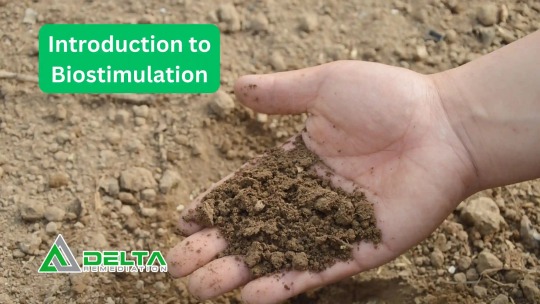
Unleashing the Power of Biostimulation: A Blueprint to Soil Microbe Optimization for Effective Pollution Treatment
Unmasking Biostimulation
Biostimulation is a cutting-edge application in environmental science, drawing upon the potency of natural processes to rectify man-induced predicaments such as soil pollution.
Deciphering Biostimulation
The heart of biostimulation lies in augmenting the indigenous microbial population dwelling within the soil. This bioremediation process fosters the expansion and functionality of these native microbes, enabling them to degrade organic pollutants with increased efficiency.
The Biostimulation Phenomenon
The DNA of Biostimulation
Biostimulation's lifeblood is to furnish an optimum habitat for microbes. When placed under perfect conditions, these tiny organisms can skillfully dismantle pollutants.
The Biostimulation Blueprint
The biostimulation procedure springs into action with an examination of the soil, quantifying the microbial presence and the degree of contamination. Following this evaluation, a tailored biostimulation strategy is concocted and executed, typically involving nutrient enrichment or other stimulating additives.
Microbes: The Unsung Heroes of Biostimulation
Microorganisms, predominantly bacteria, are the linchpins in the biostimulation system. These minute entities, ubiquitous in the soil, possess the capability to dismantle various pollutants under favorable circumstances.
The Tools of Biostimulation
Nutrient Infusion
Like all life forms, microbes demand nutrients to prosper. Supplying them with nitrogen, phosphorus, potassium, and other essential micronutrients can amplify their populace and metabolic vigor.
Emulsified Vegetable Oils
These oils serve as a gradual carbon source, fostering sustained microbial activity in the soil.
Regulation of Moisture and Air
Microbial decomposition often necessitates water and oxygen. Therefore, moisture and air are intermittently pumped into the polluted soil to promote microbial activity.
The Upsides of Biostimulation
Biostimulation proves to be a cost-efficient and eco-friendly strategy. It harnesses nature’s own janitorial squad, thereby negating the use of damaging chemical treatments or costly mechanical extractions.
The Variables in Biostimulation
The triumph of biostimulation is hinged on numerous aspects, including the soil's properties, the contaminants' character, and the native microbial populace. This necessitates exhaustive preliminary evaluations as a universal approach would not suffice.
Biostimulation vs Bioaugmentation
While biostimulation centers on boosting the native microbial community, bioaugmentation is a complementary process that imports specialized microbes into the soil to expedite the degradation procedure.
Biostimulation in the Real World
Spotlight on Biostimulation
Biostimulation has displayed its efficacy in addressing oil spills, industrial waste leaks, and even fallout from nuclear calamities. It is also being probed in the realm of agriculture for superior soil fertility management and pest deterrence.
Biostimulation: The Road Ahead
Amid escalating environmental concerns, biostimulation harbors immense potential. Progress in research and technological advancements might soon canonize this method as a mainstream practice for soil decontamination.
Epilogue
Indeed, biostimulation serves as a natural, cost-effective, and efficient antidote to soil pollution. As we journey towards a greener future, employing the prowess of microbes via biostimulation will be instrumental in safeguarding our environment.
Frequently Asked Questions
What underpins biostimulation?
Biostimulation pivots on the enhancement of the soil's native microbial community to dismantle organic pollutants.
What influences biostimulation's success rate?
Aspects such as soil type, contaminant nature, and the regional microbial population shape the success of biostimulation.
How does biostimulation square up to bioaugmentation?
Biostimulation focuses on stimulating the existing microbial community, while bioaugmentation brings specialized microbes into the soil.
What are the common applications of biostimulation?
Biostimulation has found utility in handling oil spills, industrial waste leaks, and in agriculture for maintaining soil fertility and pest control.
What lies in store for biostimulation?
With mounting environmental apprehensions, biostimulation is poised to become a standard operation for soil decontamination.
#Biostimulation in Environmental Science#Soil Microbe Optimization#Effective Pollution Treatment#Natural Remediation Methods#Biostimulation vs Bioaugmentation#Bioremediation Process#Soil Decontamination Techniques#Microbial Role in Pollution Treatment#Organic Pollutants Degradation#Cost-Effective Soil Remediation#Biostimulation in Agriculture#Eco-friendly Pollution Remediation#Role of Microorganisms in Soil Health#Nutrient Enrichment in Soil#Biostimulation in Industrial Waste Management#Soil Fertility and Pest Deterrence#Soil's Native Microbial Community#Biostimulation for Oil Spill Treatment#Sustainable Soil Decontamination Methods#Biostimulation and Soil Health
0 notes
Text
Scientists are very serious.
This is a post about science. And soup.
Dr. Elinne Becket, a microbiologist from Cal State University, is in the middle of one of those Fridge Experiments that happens to us all - except in this case, she is uniquely placed to unravel the science down to the microbial level.
While cleaning out her fridge, Dr. Becket found that a tub of family-recipe beef vegetable soup had turned bright blue. “Ok I'm outing myself here,” she tweeted, “but there was forgotten beef soup in our fridge we just cleaned it out and it was BLUE?!?!? Wtf contam would make it blue??? Like BRIGHT blue!! Even w/ all my years in micro I'm not handling this well.“
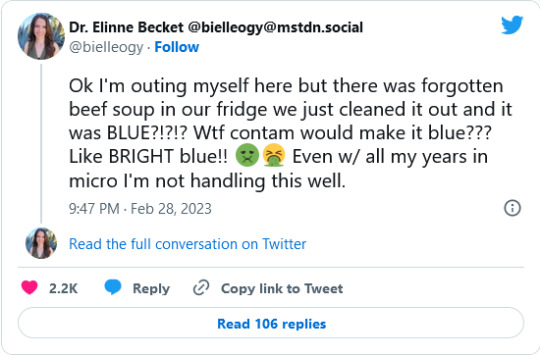
Read on for a breathless and ongoing saga of Soup and Science, and the wonderful international community that is Academic Twitter.
Academic Twitter quickly reminded her of her Responsibilities to Scientific Inquiry. (Cue the chanting from around the world of “CLONE THE SOUP! CLONE THE SOUP!”)
“I can’t believe y’all talked me into going back into the trash.” she tweeted in response, over a photo of a puddle of beautiful Mediterranean-sea blue soup in the trash bin, with bits of veg and noodles arising from the depths.

Scientists being scientists, Dr. Becket agreed to take a sample and send it to colleagues for cloning and microbial analysis.This involved getting arms-deep into the trash bin of Old Soup. “I’m never forviging @ATinyGreenCell (genomic biologist Sebastian Cocioba) for this.” Dr. Becket tweeted, with a photo of a properly dipped and snipped and VERY blue q-tip in a small clear plastic tub.

Diving into decomposing soup was not the only hazard. She writes: “My mom (who made the soup for my birthday) came across this thread and now 1) I have to answer for letting her soup spoil and 2) she's worried @ATinyGreenCell will figure out her secret recipe.“
Dr. Becket and Sebastian were able to culture the Blue Goo!
Becket posted a photo of three petri plates of streaked beef bouillon agar at 72 hours incubation, at 37C, room temp and 4C. She writes: “Left the plates where they were for another 2 days, except the 37°C one was brought to RT, which then grew white stuff over the yellow stuff and stinks to high heaven. RT looked the same. 4°C had impressive growth. Restreaked them all onto TECH agar, awaiting results!”

Sebastian, from his lab, tweeted a photo of three more covered petri dishes, with early results: “Great progress on isolating the glowy microbe from our #BlueSoup! It's so fluorescent the streak is GREEN. Still needs another restreak as it seems there is a straggler but should clear up in the next plate. Exciting!”
Then yesterday, Sebastian tweeted out an updated photo of his plates under daylight and blacklight. “Whatever grew on the #BlueSoup colony plates overnight glows under UV, but only on King's Agar B! That particular media is used to tease out fluorescein expression in pseudomonads. What are the chances that the same cell line expresses fluorescent AND blue pigments?“

“Looking closer, there definitely is a handful of different microbes showing distinct phenotypes. Could be that the blue producer and the fluorescent microbes are totally different microbes!”
At which point, Professor Cynthia Whitchurch of Norwich, England, responded: “Consistent with P. fluorescens being at least part of the #BlueSoup community. The fluorescence is due to production of the siderophore pyoverdine which is up-regulated when iron availability is limited. P. aeruginosa produced this too but my guess is you have blue Pf.”
And Australian agricultural researcher @WAJWebster helpfully tweeted a petri dish of ALL KINDS of colourful bacterial colonies from white to yellow to orange to stark black, with a cheerful: “You need bact-o--colours? I got you, fam.”
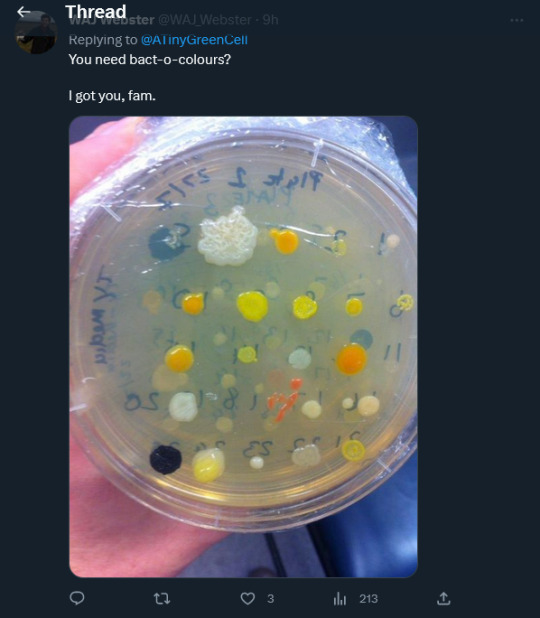
The best part is that as of today, March 9, 2023, THE BLUE SOUP MYSTERY CONTINUES. WE ARE WATCHING SCIENCE HAPPENING!
A paper is being written. And Dr. Becket’s mum is getting an author credit as the proprietary owner of the #BlueSoup recipe.

Dr. Becket’s Twitter is here: https://twitter.com/bielleogy
Sebastian Cocioba’s Twitter is here: https://twitter.com/ATinyGreenCell
Fun IFLS story is here: https://www.iflscience.com/microbiologist-investigates-after-her-beef-soup-turned-blue-in-the-freezer-67894?fbclid=IwAR0H27KqVZhzzrosnjzzKkxuKASZ-0L0Lt6hGwCRDJK8xvFbbSlyS4JvwlM
15K notes
·
View notes
Text
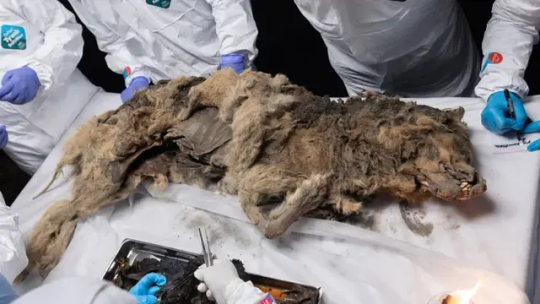
A Mummified 44,000-Year-Old Wolf Found in Siberian Permafrost
Scientists perform necropsy on an ancient wolf pulled from Russian permafrost that may still have prey in its stomach.
In a first-of-its-kind discovery, a complete mummified wolf was pulled from the permafrost in Siberia, after being locked away for more than 44,000 years. Scientists have now completed a necropsy (an animal autopsy) on the ancient predator, which was discovered by a river in the Republic of Sakha — also known as Yakutia — in 2021.
This is the first complete adult wolf dating to the late Pleistocene (2.6 million to 11,700 years ago) ever discovered, according to a translated statement from the North-Eastern Federal University in Yakutsk, where the necropsy was performed. The discovery, scientists say, will help us better understand life in the region during the last ice age.
Photos from the necropsy show the wolf's mummified body in exquisite detail. Animals are preserved in permafrost through a type of mummification involving cold and dry conditions. Soft tissues are dehydrated, allowing the body to be preserved in a frozen time capsule.
Researchers took samples of the wolf's internal organs and gastrointestinal tract to detect ancient viruses and microbiota, and to understand its diet when it died.
"His stomach has been preserved in an isolated form, there are no contaminants, so the task is not trivial," Albert Protopopov, head of the department for the study of mammoth fauna of the Academy of Sciences of Yakutia, said in the statement. "We hope to obtain a snapshot of the biota of the ancient Pleistocene."


He added the wolf, which tooth analysis revealed was male, would've been an "active and large predator," so they will be able to find out what it was eating, along with the diet of its victims, which "also ended up in his stomach."
Another key aspect of the necropsy is looking at the ancient viruses the wolf may have harbored. "We see that in the finds of fossil animals, living bacteria can survive for thousands of years, which are a kind of witnesses of those ancient times," Artemy Goncharov, who studies ancient viruses at the North-Western State Medical University in Russia, and is part of the team analyzing the wolf, said in the statement.
He said the research project will aid their understanding of ancient microbial communities and the role of harmful bacteria during this period. "It is possible that microorganisms will be discovered that can be used in medicine and biotechnology as promising producers of biologically active substances," he added.
The wolf necropsy is part of an ongoing project to study the wildlife that lived in the region during the Pleistocene. Other species examined include ancient hares, horses and a bear from the Holocene. The team plans to study the wolf's genome to understand how it relates to other ancient wolves from the region, and how it compares to its living relatives. The team now plans to start studying another ancient wolf discovered in the Nizhnekolymsk region of northeast Siberia in 2023.
By Hannah Osborne.





#A Mummified 44000-Year-Old Wolf Found in Siberian Permafrost#mummified wolf#Republic of Sakha#Yakutia#late pleistocene#ancient animals#ancient artifacts#archeology#archeolgst#history#history news#ancient history#ancient culture#ancient civilizations
311 notes
·
View notes
Text
The human body's inability to break down sucralose, an artificial sweetener found in many zero-calorie food and drink products, is well established by scientific research. The compound is so stable that it escapes wastewater treatment processing and is in drinking water and aquatic environments.
"We can't break down sucralose, and a lot of microorganisms can't break it down, either, because it's a really tough molecule that doesn't degrade easily. So there are a lot of questions about how it is affecting the environment and whether it's something that could impact our microbial communities," said Tracey Schafer, an assistant research scientist for the University of Florida's Whitney Laboratory for Marine Bioscience and the soil, water and ecosystem sciences department, part of UF's Institute of Food and Agricultural Sciences.
Continue Reading.
239 notes
·
View notes
Text
I know this is typically for pet pics and people's calligraphy to share with you but I just saw an article on phys.org that was about sourdough starters and what using different flours for it does for smell and taste and thought of you? if the link sends, it's here! I hope this is an okay use of the submission box.
OH YO??? NO this is EXTREMELY helpful i bookmarking this thing to read for later
531 notes
·
View notes
Text
"An international research team has found almost a million potential sources of antibiotics in the natural world.
Research published in the journal Cell by a team including Queensland University of Technology (QUT) computational biologist Associate Professor Luis Pedro Coelho has used machine learning to identify 863,498 promising antimicrobial peptides -- small molecules that can kill or inhibit the growth of infectious microbes.
The findings of the study come with a renewed global focus on combatting antimicrobial resistance (AMR) as humanity contends with the growing number of superbugs resistant to current drugs.
"There is an urgent need for new methods for antibiotic discovery," Professor Coelho, a researcher at the QUT Centre for Microbiome Research, said. The centre studies the structure and function of microbial communities from around the globe.
"It is one of the top public health threats, killing 1.27 million people each year." ...
"Using artificial intelligence to understand and harness the power of the global microbiome will hopefully drive innovative research for better public health outcomes," he said.
The team verified the machine predictions by testing 100 laboratory-made peptides against clinically significant pathogens. They found 79 disrupted bacterial membranes and 63 specifically targeted antibiotic-resistant bacteria such as Staphylococcus aureus and Escherichia coli.
"Moreover, some peptides helped to eliminate infections in mice; two in particular reduced bacteria by up to four orders of magnitude," Professor Coelho said.
In a preclinical model, tested on infected mice, treatment with these peptides produced results similar to the effects of polymyxin B -- a commercially available antibiotic which is used to treat meningitis, pneumonia, sepsis and urinary tract infections.
More than 60,000 metagenomes (a collection of genomes within a specific environment), which together contained the genetic makeup of over one million organisms, were analysed to get these results. They came from sources across the globe including marine and soil environments, and human and animal guts.
The resulting AMPSphere -- a comprehensive database comprising these novel peptides -- has been published as a publicly available, open-access resource for new antibiotic discovery.
[Note: !!! Love it. Open access research databases my beloved.]"
-via Science Daily, June 5, 2024
#superbugs#bacteria#viruses#microbiology#antibiotics#medicines#public health#peptides#medical news#antibiotic resistance#good news#hope#ai#artificial intelligence#pro ai#machine learning
178 notes
·
View notes
Note
Hi! I really love your metas and they’ve cleared up a lot of what I missed when I read the books. I was wondering if I could ask you a question. (Totally fine if not!)
So we know that John killed the entire Solar System because he was angry the trillionaires got to escape a dying Earth and leave of the rest of its inhabitants behind. He details killing Earth, the Sun, the other planets. My question is, what happened to the moons? Did he overlook them? Did the Lyctors get to them later?
I ask because I’m wondering if the moons have anything to do with the Resurrection Beasts and/or their Heralds. Frankly, I’m just curious about what happened to them.
I get that killing a planet and everyone and everything on it would create a Resurrection Beast. But I’m wondering if size matters. Pluto is a dwarf planet. I’m sure there are moons that are larger. I’m not sure whether life-supporting environments mattered either. I can’t recall if any of the planets had stations that could maintain human life before the Resurrection.
John mentioned killing the Sun and later resurrecting it into Dominicus. I thought that was interesting because there is no way humans could have lived near or on the surface of the Sun, so its thalergenic potential would be incredibly limited if not zero, right? But it is now a thanergetic celestial body. Dominicus is remarked upon in the books and seems to have some significance because it is tied to John’s life. (Or was that a lie he told the Lyctors? I don’t remember.)
In comparison, moons get almost no mention. I’m wondering if that’s a choice or if there are just some thalergenic moons in the Dominican System. That seems unlikely to me and I’m wondering at the significance.
Perhaps I’m overthinking it lol. What are your thoughts?
I'm honestly so confused about moons.
There's only two references to moons that I can think of:
Mercymorn says to Harrow "I'm going to go do the moonlet next door. It'll be covered in reflected thalergy." But what is a moonlet, and is this a real phenomenon, or just one she made up as an excuse for Harrow to encounter the BoE crew?
And of course, there's Pyrra's "half-flipped moon", which is again rather confusing - what does it mean to be 'half-flipped'?
John doesn't mention them in his Very Hungry Caterpillar adventures, and there's no direct references to moons from any of the other Housers we meet - with the exception of Gideon using 'moonspeak' to mean something like technobabble or nonsense. There's no specifically moon-based pre-res stations mentioned that I can recall - there's some kind of city on Mars, the Kuiper Platform (perhaps near Neptune), and the shell being built around Uranus. So we can't assume RBs for Jupiter and Saturn came solely from humans living near them.
The Glossary in GTN goes out of its way to specify that "planets and gaseous bodies in space usually produce thalergenic radiation." It further says, "thalergy is produced by cellular growth and reproduction. Most planets, even ones without a biological mass of life, are thalergenic." So that's clear... The waters are further muddied by the explanation we get in HTN, where Harrow says thalergy "comes from the accumulation of microbial life" and John talks about how this produces a "communal soul". From the way John describes it, a revenant seems to the result from any swift planetary murder.
So thalergy is caused by an accumulation of microbial life which creates a communal planetary soul...but gaseous bodies also radiate thalergy?
I think there's two possibilities here.
The first is that we try to treat this as a properly sci fi endeavour to create a fantastical yet scientifically cohesive system, and we assume that perhaps that radiated thalergy Mercymorn describes relates to the idea that anything within the planet's gravitational orbit is part of its communal self. Perhaps the gas giants draw their thalergy from as-yet-undiscovered microbial life on their moons? Perhaps the sun is the sum of the solar system in some way?
The second is to assume that while this story is fiction that portrays scientific understandings in its fictional world, it is fundamentally a story about metaphysics. So the value of a moon is not determined by having a particular amount of microbial life or a specific relationship with another planet, but some mythological or metaphysical purpose - for the most part, moons aren't symbolically important to the story as it's being told.
So perhaps the moons of the solar system are part and parcel with the RBs of their planets.
61 notes
·
View notes
Text
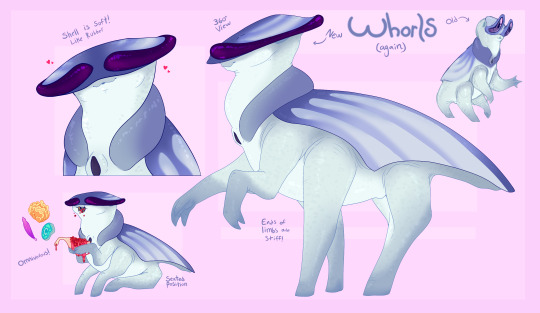
Finally finished my Whorl redesign. They were cute before but idk, I wasn't digging their eyes. I gave them a frisbee head and they are much better for it now! More in depth info to be found below!
Whorls are a sophont from the slime ball planet Backera, the planets crust is entirely covered in miles thick microbial mat so the floor is always very much alive. The main form of "animal" life on the planet are the pentapods, analogous to Earth tetrapods in terms of niches and all that. Pentapods are distinguished by their five limbs, five jaws, partial exoskeleton, and an internal boney limb girdle.
Whorls are from a clade of predatory pentapods who branched into frugivory a while back, eventually leading to tighter knit communities built around maintaining their farm mats. Whorls live in towns with populations between a few dozen to a few thousand, their settlements are also how they get their name. Their buildings are spiral shaped, expanded by spiraling them outward! I'm getting around to drawing that, its v cool.
They eat mostly 'plant' matter, fruiting bodies from sessile organisms and maybe some choice floor scrapings. Meat is also greatly enjoyed, but is typically reserved for older Whorls or very small children. Children who by the by, go through a little aquatic stage before committing to wet land. Babies are traditionally left to grow in slow moving rivers, but modern times find communal pools to be a lot more popular.
Whorl families consist of one 'bearing' parent and anywhere from 1-5 'seeding' parents. Whorls do not have sexes, but they do have a few genders! Mostly they have to do with who is stabbing/getting stabbed and gender will change throughout a Whorls life. An important note here though is that most pentapods, including Whorls, fertilize via traumatic insemination stab. This is understandably rough on the stabbee so generally only older, larger individuals will be the ones going through pregnancy.
That's the basic gist, will get more into it as I get around to it. But just wanted to reboot them a little!
279 notes
·
View notes
Photo

Did you know that three of the most catastrophic volcanic eruptions in geological history occurred at Yellowstone National Park? 🌋Located in northwestern Wyoming, Yellowstone’s supervolcano is currently dormant: Its last powerful eruption occurred approximately 600,000 years ago. Yet, this sleeping giant is still active. At Yellowstone today, geothermal activity rumbles beneath the Earth, fueling geysers and hot springs— including the Grand Prismatic Spring, pictured here. Its rings of striking color represent different microbial communities. The bacteria that live in these near-boiling waters endure temperatures of up to 175˚F (79˚C). Entire food chains depend on these microorganisms. Colorful cyanobacteria cover the wet rocks; flies consume the bacteria; mites live on the flies; and the flies are eaten by predatory wolf spiders. Photo: Carsten Steger, CC BY-SA 4.0, Wikimedia Commons #nature #nationalparks #amazingplanet #naturephotography #landscape https://www.instagram.com/p/CoS4ieXvwaW/?igshid=NGJjMDIxMWI=
537 notes
·
View notes
Text
Notes as an indigenous farmer for other farmers, gardeners, looking to seek to perform land remediation, restorative agroforestry, etc.
First, look up historical weather and current weather zoning, climate change is real, the area may no longer be suitable for specific plants anymore.
Consider invasive plants, animals, worms(yes like bees there are invasive worms) , etc
Assess potential soil and water pollution sources then create a remediation plan depending on time and feasibility.
Work with the land, not against it, this is pretty simple, if you plan to create rain collecting channels for your small garden, then it's to slope where the land slopes for you.
Composting is great but you also need to understand microbial/fungal symbiosis and creating microbiomes that allow for effective compost break down.
You can buy cheap microbial solutions that are epa or environmental sound, back reference any microbial cultures with academic papers, if unsure how to do the research then it is fine with a variety as this simulates closely to nature.
Look into outdoor mushroom farming, this is pretty common in my community in our Chināmitl /mīlpan system, it's not as hard as most resources online will tell you, especially if you're sticking with native to your area mushrooms.
Avoid commercial strains for cultures especially if they're non native as this can lead to potential invasives.
Yes fungus /mushrooms can be invasive, please never put golden oyster outside.
You can also buy microremediating solutions for soil/water contamination.
Many universities offer resources to help find soil or water testing companies for accessible to no costs even, this is useful if you want to assess variety of conditions.
Additionally microbe /fungal based solutions are most used in our community as it helps reduced overall pests and diseases to our plants.
If you have tons of untreated wood ash (burn untreated wood, get wood ash) this is useful for variety of things, as this ties into controlled burning, true slash and burn, etc. Essentially nutrients are allowed to disperse back in the ground, be aware of heavy metal and other contamination considerations as always.
Indigenous seed banks do exist for non indigenous people, also look into seed conservation projects and seed banks that look to preserve seed lineages. While heirloom is nifty, it does only go so far back around an early colonial era.
54 notes
·
View notes
Text

DEEP-SEA MINING MIGHT HARM RARE JELLYFISH
New research shows mining of the deep ocean floor for rare minerals could harm deep-sea jellyfish by stressing them out with sediment plumes, suggests a study of how resource harvesting might affect the helmet jellyfish (Periphylla periphylla), a luminescent red-colored cnidarian of the deep sea.
While deep sea animals provide important ecosystem functions including climate regulation, species-specific responses to stressors remain poorly understood. Researchers collected helmet jellyfish and exposed them to sediment at concentrations that could be churned up by mining. After a day, the animals had mucus covering much of their bodies, among other signs that they were really not well, being stressed and using a lot of energy to rid out of the floating sediment, which could be harmful over extended periods.
Suspended sediment plumes provoked the most acute and energetically costly response through the production of excess mucus. Microbial symbionts appeared to be unaffected by both stressors, with mucus production maintaining microbial community composition. If these responses are representative for other gelatinous fauna, an abundant component of pelagic ecosystems, the effects of planned exploitation of seafloor resources may impair deep pelagic biodiversity and ecosystem functioning.
Photo by Bjørnar Solhaug
Reference (Open Access): Stenvers et al., 2023. Experimental mining plumes and ocean warming trigger stress in a deep pelagic jellyfish. Nature Communications
#science#deep sea#deep sea mining#conservation#marine conservation#biology#marine biology#Periphylla periphylla
95 notes
·
View notes
Text
Clean EVAs
When conducting an EVA, it is always important to maintain both a sterile communication environment, as well as a microbially-sterile pressurelock environment.
It is your responsibility as a spacewalker to maintain that sterile environment, both for the safety of yourself and of others. After every jump, and whenever in the jump, you must remember to follow Clean EVA procedures.
The exterior of almost every pressurised vessel in space is host to anaerobic bacteria and extremophiles, due to transfer from internal atmosphere, or from components constructed by hand. Some microbes may develop stronger resistance to radiation and extreme temperature through exposure to conditions experienced by an average spaceframe — while radiation and extreme temperature are themselves currently the most common methods for sterilising microbial life, in medical equipment, scientific instruments, and foodstuffs.
Review Questions 1
39 notes
·
View notes